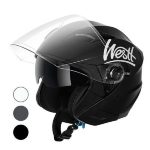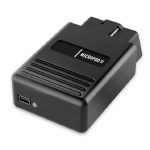Motorcycle helmets are crucial for protecting your head during rides, but they don’t last forever. Knowing when to replace your helmet is key to ensuring your safety on the road. This guide will cover everything you need to know about when and why you should replace your motorcycle helmet.
Understanding the Lifespan of a Motorcycle Helmet
Motorcycle helmets are designed with a specific lifespan in mind. How often to replace a motorcycle helmet? Manufacturers typically recommend replacing your helmet every five years. This recommendation is based on the natural aging process of the materials used in helmet construction, such as the breakdown of resins, glues, and the internal foam liner. However, the frequency of replacement can vary depending on several factors, including usage, environmental conditions, and the quality of the helmet.

Factors That Affect Helmet Lifespan
- Material Degradation: Helmets are made of materials like fiberglass, carbon fiber, polycarbonate, and ABS plastic, all of which can degrade over time due to exposure to UV rays, heat, and moisture. The outer shell, in particular, can become brittle and less effective at absorbing impacts as it ages.
- Frequency of Use: The more often you ride, the quicker your helmet will wear out. Regular use causes the inner foam to compress, reducing its ability to absorb shock during an impact. Riders who are on the road daily may need to replace their helmets more frequently than those who ride occasionally.
- Sweat and Hair Products: Sweat, hair oils, and other products can accelerate the deterioration of the inner padding and liner. This can lead to a less secure fit and reduced comfort, which in turn affects the helmet’s protective capabilities.
- Accidents and Drops: Even if a helmet looks intact after an accident or a significant drop, its integrity could be compromised. The foam inside is designed to absorb one major impact, and any subsequent damage can reduce its ability to protect you in another crash.
Signs It’s Time to Replace Your Helmet
While the five-year rule is a good general guideline, there are specific signs that indicate your helmet might need to be replaced sooner.

1. Visible Damage
Check your helmet regularly for cracks, dents, or scratches on the outer shell. These could be signs that the helmet’s structure has been compromised. Even small cracks can significantly reduce the helmet’s ability to protect you in an accident.
2. Loose Fit
Over time, the helmet’s interior foam and padding can compress, causing the helmet to fit more loosely. A helmet should fit snugly; if it starts to wobble or shift when you move your head, it’s time for a replacement.
3. Worn-Out Liner and Padding
The inner padding not only provides comfort but also plays a crucial role in absorbing impact. If the liner has become thin, frayed, or worn out, it won’t protect you as effectively.
4. Strap and Buckle Issues
The chin strap and buckle are essential for keeping the helmet securely on your head. If the strap becomes frayed or the buckle starts to malfunction, your helmet won’t stay in place during a crash.
5. Faded Colors
UV exposure can cause the helmet’s colors to fade, which is more than just a cosmetic issue. Fading can indicate that the materials are degrading and that the helmet may no longer offer the same level of protection.
When to Replace Your Helmet After an Accident
One of the most critical times to replace your helmet is after any kind of accident, even if the damage isn’t visible. Helmets are designed to absorb the energy from an impact by deforming the inner foam liner. Once this liner has been compressed, it won’t be as effective in another crash. Therefore, if you’ve been in an accident, replace your helmet immediately, regardless of its age.
How to Extend the Life of Your Motorcycle Helmet
While you should always adhere to the manufacturer’s replacement guidelines, there are ways to extend the life of your helmet:
- Proper Cleaning: Regularly clean both the exterior and interior of your helmet using mild soap and water. Avoid using harsh chemicals that could degrade the materials. Make sure the helmet is thoroughly dry before storing it.
- Avoiding Chemical Exposure: Keep your helmet away from gasoline, cleaning solvents, and other harsh chemicals, as these can weaken the outer shell and inner components.
- Safe Storage: Store your helmet in a cool, dry place away from direct sunlight when not in use. Extreme temperatures can cause the materials to break down faster.
- Use a Helmet Liner: Wearing a helmet liner or balaclava can help absorb sweat and oils, reducing the wear on the inner padding.
Common Myths About Helmet Replacement
There are a few myths about motorcycle helmet replacement that need to be addressed:
Myth 1: You Only Need to Replace a Helmet If It’s Been in an Accident
While accidents are a definite reason to replace a helmet, normal wear and tear from regular use also necessitates replacement. The materials in a helmet degrade over time, even if you’ve never been in a crash.
Myth 2: Expensive Helmets Last Longer
Price does not necessarily correlate with longevity. All helmets, regardless of cost, are subject to material degradation over time. While more expensive helmets may offer better initial comfort, features, or brand prestige, they still need to be replaced within the same general timeframe.
Myth 3: If It Looks Fine, It’s Fine
A helmet can look perfectly fine on the outside but still be compromised on the inside. The internal foam can deteriorate without showing any visible signs, so it’s crucial to follow replacement guidelines even if your helmet appears undamaged.
Choosing Your Next Helmet
When it’s time to replace your helmet, consider the following factors to ensure you’re getting the best protection:

- Safety Ratings: Look for helmets that meet or exceed safety standards like DOT, ECE, or Snell. These certifications ensure that the helmet has been tested for impact resistance, penetration, and retention.
- Fit and Comfort: A helmet should fit snugly without being uncomfortable. Try on several models to find the one that fits your head shape the best.
- Features: Consider features like ventilation, visor options, and Bluetooth compatibility. These can enhance your riding experience, but safety should always be your top priority.
- Material: Helmets made from materials like carbon fiber or fiberglass are typically lighter and stronger, but they can be more expensive. Polycarbonate helmets are more affordable but might not last as long.
- Price vs. Value: While it might be tempting to buy a cheaper helmet, remember that your safety is at stake. Invest in a helmet that offers the best protection for your budget.
Your Safety is Worth the Investment
Your motorcycle helmet is your most important piece of safety gear, and knowing when to replace it is crucial for protecting your life on the road. While helmets are designed to be durable, they can degrade over time, affecting their ability to provide adequate protection. By following the guidelines outlined in this article, you can ensure that you’re always riding with a helmet that is in optimal condition.
Key factors to consider when determining when to replace your motorcycle helmet:
- Age: Even if your helmet appears undamaged, it’s recommended to replace it every five years due to the natural degradation of materials over time.
- Accidents and incidents: If your helmet has been involved in a crash or suffered a significant impact, it’s imperative to replace it immediately, as the protective integrity may have been compromised.
- Signs of wear and tear: Look for signs of damage, such as cracks, scratches, or a loose chin strap. If you notice any of these issues, it’s time for a new helmet.
- Manufacturer recommendations: Refer to the manufacturer’s guidelines for specific replacement recommendations and any warranty information.
By prioritizing helmet safety and replacing your helmet when necessary, you’re making a significant investment in your well-being and enjoying the peace of mind that comes with knowing you’re riding with the best protection available.


